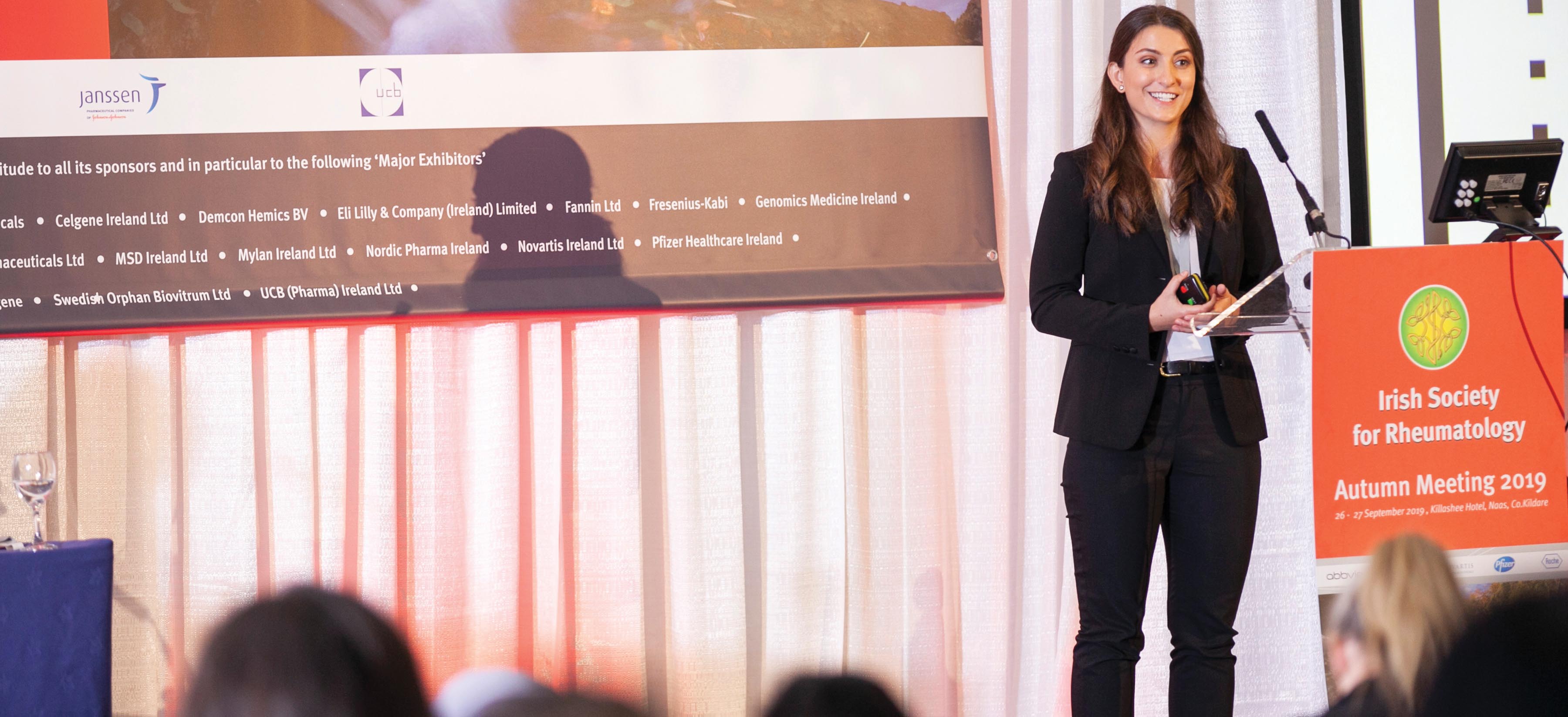
Ioana Tereza Florica - Bernard Connor Medal Winner
The winner of the
2019 ISR Bernard Connor Medal was Tereza Florica, a Canadian third-year
graduate entry medical student at University College Cork, whose project
focuses on myocardial involvement of myositis.
Ms Florica gave a well-received presentation at the 2019
ISR Autumn Meeting, where she revealed that during her rheumatology
placement in Cork University Hospital, she came across three patients with
diagnostic dilemmas in relation to myocardial involvement of myositis. “These
difficult cases inspired me to explore this rare and complicated disease.”
The diversity of myositis disease presentation results
in diagnostic difficulty across medical specialties.
“They say that lupus is the ‘disease of a thousand
faces’ but the same could be said about myositis,” she explained. The extended
myositis antibody (EMA) panel, though not yet routine, has documented utility,
prognostic value, and gives structure to treatment options. However, myocardial
involvement is one of the rarer manifestations of myositis (~3%). “Due to the
many different symptomatic or asymptomatic presentations, and lack of
established diagnostic procedures, this dangerous but treatable condition can
be misdiagnosed,” she said.
Cardiac MRI shows promise as a tool for detecting both
focal and diffuse myocardial involvement and is significantly correlated with
elevated troponin.
Ms Florica cited the three female cases she came across
during her placement which highlighted this.
Patient 1, with a background history of limited
scleroderma, (ANA+, ENA-) presented three weeks post-partum after a
Caesarean-section at 34 weeks, complicated by acute HELLP (Haemolysis, Elevated
Liver enzymes, and Low Platelet count) syndrome. Once discharged, she
experienced progressive shortness of breath on exertion and fatigue, which she
attributed to anaemia from pregnancy-related blood loss. She then developed PND
and orthopnoea, with refractory hypertension. This prompted hospital admission
under the care of cardiology, where she was treated for protracted
pre-eclampsia. Following discharge, she had ongoing symptoms and on review in
rheumatology OPD, was found to have elevated creatine kinase
(1,853;26-192IU/L), LDH (1180;135-214IU/L), and troponin (545;<14ng/L). She
was readmitted clinically, in mild cardiac failure. Cardiac MRI showed no
abnormalities to suggest infiltration or scarring of the myocardium. While in
hospital, an EMA panel was conducted and revealed positive PM/Scl antibodies,
often associated with systemic sclerosis/myositis overlap.
The patient improved after treatment with rituximab and
tapering prednisolone, and went on successfully to have a second child.
Patient 2 presented with bilateral lower-limb pitting
oedema, proximal muscle weakness and a four-day history of non-pruritic
maculopapular rash localised to the upper limbs, abdomen, and thighs. She was
also experiencing fatigue and shortness of breath on exertion, but she
attributed these symptoms to the onset of menopause. Patient 2 also had
remarkably elevated creatine kinase (16,556;26-192IU/L), LDH (7,671;135-214IU/L)
and troponin (723;<14ng/L). However, both echocardiogram and cardiac MRI
were grossly normal. She was a patient known to the clinic with active
rheumatoid arthritis, treated with adalimumab. An EMA panel revealed positive
anti-Jo-1 antibodies; an antibody directed against histidyl-tRNA synthetase and
one of the antibodies under the classification of anti-synthetase syndrome.
Myocarditis is recognised as a rare but severe manifestation of anti-synthetase
syndrome but the criteria for its diagnosis are unclear. In addition, EMG and
muscle biopsy findings implied acute myopathy with muscle fibre necrosis. This
patient’s symptoms were alleviated by treatment with rituximab.
Patient 3, a previously healthy woman, presented with a
six-week history of fatigue, diaphoresis, rash, insomnia and migrating
polyarthralgia. She also experienced occasional palpitations and chest
tightness, but no dyspnoea. She denied all other cardiac and respiratory
symptoms. The patient attributed her symptoms to the onset of menopause. She
had bilaterally reduced air entry, basal inspiratory crepitations and a soft
ejection murmur, but no pedal oedema.
On admission,
troponin levels were elevated and continued to increase over time to a peak of
163 (<14ng/L). New ECG changes showed T-wave inversions in leads V4, V5, II
and III. An echocardiogram was grossly normal, while a cardiac MRI showed
mediastinal lymphadenopathy and multiple abnormal areas of delayed enhancement,
suggesting myocardial inflammation. An EMA panel revealed positive PL-12
antibodies, another one of the antibodies under the classification of
anti-synthetase syndrome. In this patient, treatment with rituximab was
insufficient and thus cyclophosphamide was added, alleviating her symptoms.





Leave a Reply
You must be logged in to post a comment.